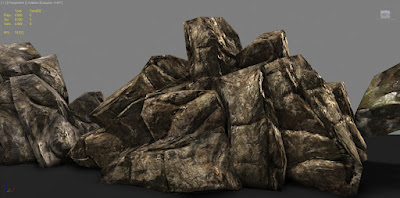jo hi, i just tried out a modeling technique for tileable stone textures. i used supporting edges around the corners, and then gave everything the same smoothing group.the meshes are not optimized then, so quite many polys here. the result is not that cool how i hoped for.
there are 5 different materials all on the same mesh. 1 diffuse, 1 normal, one specular.
always 2 lights with realtimeshader in 3dsmax viewport. no shadows, only ambient occlusion was on.
most of the time you will need to create tileable stonemaps in games, at least, when you're into open world games.
because the unique mapped meshes have a limitation of size, since the pixels get very large, when the prop is scaled. therefore you need tiles, to keep a reasonable texelsize.
so the cons about tileables are: seams, not very defined and blotchy geometry, therfore not readable.
so here i tried a technique, which should give the model a more defined and readable look by using supporting edges around meshcorners and then apply only 1 smoothing group to all
conclusion: when the mesh is optimized, this modeling techique can work,you will get slighty rounded corners.which can be made more solid, the more near you place the supporting edges to your corner edge.
absolutely inevitable is ambient occlusion shadow, which will give your model the depth it needs to read it well. all bigger engines will give you realtime AO shadows ingame.
if not available, a workaround could be dirtmaps in mapchannel 2 to fake AO. but thats much work.
btw. if you want to test my maps, or use them, then down them here: http://dl.dropbox.com/u/6300026/Stone_Tests.rar
have phun, i share them for free. give credit to me, if you use them, although the specs are very crappy.








So could you model anything you wanted, relaxed the mesh in the UV, and applied the texture being tiled as many times as needed to fit the rock properly?
ReplyDeleteAlso, good work.
One more thing, did you combine the AO and the diffuse after you baked the AO off the rocks?
ReplyDeletehi david, yes basically you can model any form. then relax uv. and scale the uvs to apply as many texture features on the surface as needed.
ReplyDeleteand no, the ambient occlusion is realtime computed. nothing baked.
its basically a postproduction effect that is supported in many engines out there. even 3dsmax can do it in its viewports ;)
Hi there Sascha.
ReplyDeleteBeen checking out your blog often due to you posten awesome information about game texturing and overall good information that a gamedesigner should know about. What I'm wondering about is, what kind of program are you using to create normalmaps out of the regular textures. Are you using CrazyBump or xNormal? Seems that nVidias NormalMapFilter doesnt work on Win 7 64-bit.
I've been doing some of your tutorials, and they've helped me a long way in understanding good modelling techniques for procedural props.
Keep up the good work.
Regards from Norway ;)
hi sivert, thank you very much!
ReplyDeletei appreciate your support.
i use nvidia filter on 32 bit version of photoshop, which is always also installed when installing 64 bit versions.
but you can also use the xnormal photoshop filter.
its installed with xnormal.
another cheap solution is shadermap pro. it only costs 20 bucks or so
Thank you Sascha ! great work as always !
ReplyDeleteSome files are missing in the ZIP though, diffuse 2&3 :)
Hi there..DropBox..Error ..Please Update =D thanks
ReplyDeleteThis comment has been removed by the author.
ReplyDeleteIts really good work, Keep going..
ReplyDeleteBut DropBox link Error.
Can you please update.
Thanks.